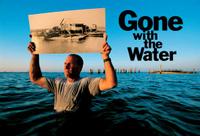 Eleven months ago National Geographic magazine predicted the effect of a future hurricane striking New Orleans.
Eleven months ago National Geographic magazine predicted the effect of a future hurricane striking New Orleans.An eerily accurate excerpt:
The storm hit Breton Sound with the fury of a nuclear warhead, pushing a deadly storm surge into Lake Pontchartrain. The water crept to the top of the massive berm that holds back the lake and then spilled over. Nearly 80 percent of New Orleans lies below sea level, —more than eight feet below in places, —so the water poured in. A liquid brown wall washed over the brick ranch homes of Gentilly, over the clapboard houses of the Ninth Ward, over the white-columned porches of the Garden District, until it raced through the bars and strip joints on Bourbon Street like the pale rider of the Apocalypse. As it reached 25 feet (eight meters) over parts of the city, people climbed onto roofs to escape it.I wonder if subscriptions are now up among government officials.
Thousands drowned in the murky brew that was soon contaminated by sewage and industrial waste. Thousands more who survived the flood later perished from dehydration and disease as they waited to be rescued. It took two months to pump the city dry, and by then the Big Easy was buried under a blanket of putrid sediment, a million people were homeless, and 50,000 were dead. It was the worst natural disaster in the history of the United States.
When did this calamity happen? It hasn't —yet. But the doomsday scenario is not far-fetched. The Federal Emergency Management Agency lists a hurricane strike on New Orleans as one of the most dire threats to the nation, up there with a large earthquake in California or a terrorist attack on New York City. Even the Red Cross no longer opens hurricane shelters in the city, claiming the risk to its workers is too great.
"The killer for Louisiana is a Category Three storm at 72 hours before landfall that becomes a Category Four at 48 hours and a Category Five at 24 hours, —coming from the worst direction," says Joe Suhayda, a retired coastal engineer at Louisiana State University who has spent 30 years studying the coast. Suhayda is sitting in a lakefront restaurant on an actual August afternoon sipping lemonade and talking about the chinks in the city's hurricane armor. "I don't think people realize how precarious we are,"
Suhayda says, watching sailboats glide by. "Our technology is great when it works. But when it fails, it's going to make things much worse."
Thanks to Wayne's World for the link.
1 comment:
Was that amazing or what?! Thanks for the link. I wondered where the traffic was coming from.
Post a Comment